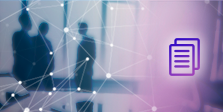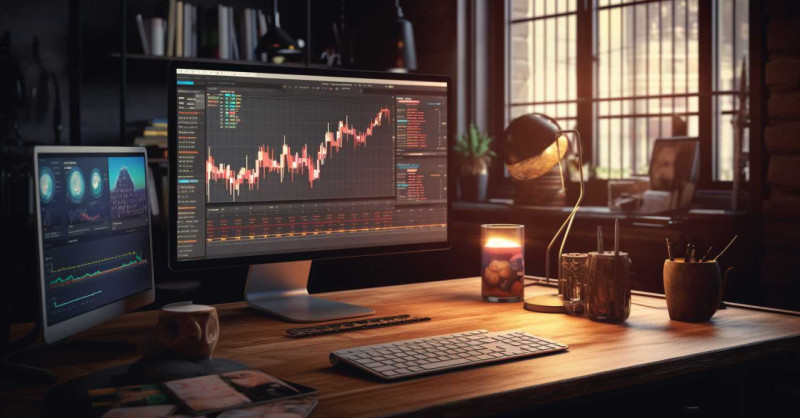
Introduction
In today's fast-paced digital world, the realm of stock, cryptocurrency, and forex trading is no exception to the rule of technological evolution. It's a universe where milliseconds can make the difference between profit and loss, and where the tools you use can be as crucial as the strategies you employ.
The heartbeat of this high-stakes game isn’t just intuition, knowledge, or luck; it's a reliable computer system. Just as a craftsman requires precise instruments to deliver quality work, traders need a computer that can seamlessly handle real-time data, execute trades instantaneously, and support the analytical tools that inform their decisions.
Choosing the right best computer for trading isn't about having the fanciest setup or the most screens, though those can help. It's about ensuring efficiency, speed, and reliability. Just imagine missing a market-moving news alert or experiencing a lag during a massive price swing; the results could be catastrophic for a trader. Therefore, the importance of a reliable computer cannot be understated.
Furthermore, trading isn’t merely about buying and selling. It's about analyzing trends, observing market movements, and executing strategies with precision. This makes the computer a trader uses not just a tool, but an extension of their strategy, methodology, and vision. In essence, selecting the right computer is not a luxury but a necessity, determining not only the efficiency of operations but potentially the success and profitability of the trades themselves.
As we delve deeper into the intricacies of what makes a computer ideal for trading, remember that in trading, every second counts. And in those seconds, your computer’s performance could be the determining factor of your success.
Why a Specialized Computer Matters in Trading
The trading world is often compared to a battlefield where every fraction of a second can be the difference between emerging victorious or facing defeat. Amidst this, a computer isn't just a tool—it's your chief weapon. Let's explore why a specialized computer is not just advantageous, but essential in this field.
Best Computer for Trading:The Fast-Paced Nature of the Trading World
Trading, be it stocks, forex, or cryptocurrencies, operates at a dizzying speed. Market prices fluctuate in real-time, and news that can impact these prices come in fast and furiously from around the world. In such an environment, opportunities can emerge and vanish in the blink of an eye. A successful trader is one who can quickly seize these fleeting moments, making swift decisions based on the influx of data. For this, they need a computer that can not only keep up but also stay ahead of the curve. A standard, off-the-shelf computer might falter under the weight of real-time streaming data, advanced trading software, and multiple open applications—leading to inefficiencies that traders simply cannot afford.
Minimizing Latency and Maximizing Speed
In the world of trading, latency is a dreaded word. Latency refers to the delay before a transfer of data begins after an instruction for its transfer has been received. In simpler terms, it's the lag time between when you click 'buy' or 'sell' and when that order is executed. High latency can mean missing your target buy or sell price, which can result in significant losses. A specialized trading computer focuses on minimizing this latency, ensuring that traders get the exact deal they intend.
Speed, on the other hand, is the computer's ability to process data. With the multitude of charts, graphs, and live news feeds traders rely on, a computer's processing speed becomes paramount. The faster a computer can process this data and execute trades, the better a trader's chances of success.
Consequences of Using a Sub-Par Computer System
Opting for a standard computer over a specialized trading one might seem like a cost-saving measure initially, but the potential losses due to its shortcomings can dwarf its initial savings. Here are some of the consequences:
- Missed Opportunities: A slow computer might freeze or lag during vital trading windows, leading to missed profitable trades.
- Financial Losses: High latency can lead to trades being executed at prices different from what was intended, leading to unintended losses.
- Inaccurate Data Analysis: Trading decisions are often based on intricate data analysis. A sub-par computer may struggle to handle advanced analytics tools, leading to faulty analyses and, consequently, bad trading decisions.
- Stress & Fatigue: Constantly dealing with system crashes, lags, or slow processing isn't just bad for business; it can also be incredibly stressful and tiring for the trader.
In conclusion, while trading requires skill, intuition, and knowledge, it's equally vital to be equipped with the right tools. A specialized computer tailored for trading ensures that technological shortcomings don't stand in the way of a trader's success. It's an investment in reliability, speed, and, ultimately, profitability.
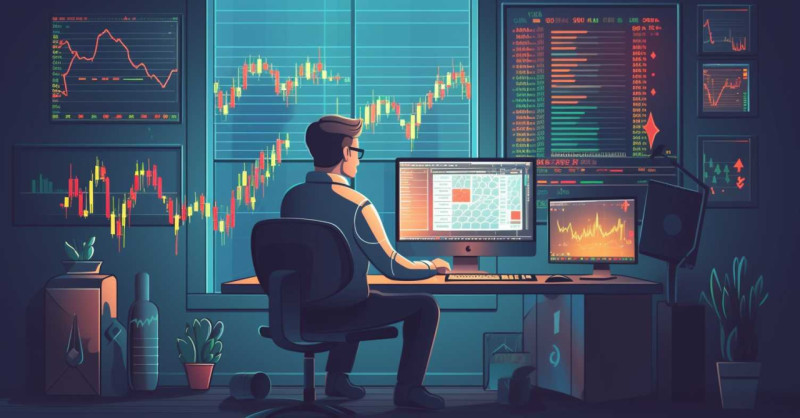
Key Components of the Best Computer for Trading
The essence of a high-performing trading computer lies in its components. Each part plays a pivotal role in ensuring seamless performance during trading sessions. Among the primary components, the Processor or Central Processing Unit (CPU) stands as the brain of the computer. Let's delve into its importance and what specifications traders should be looking for.
Processor (CPU)
Why it matters: Quick Processing of Data & Multitasking
- Real-time Data Handling: Financial markets are dynamic, with prices, charts, and trends changing constantly. The CPU processes this influx of real-time data, ensuring that traders see the most up-to-date information.
- Running Multiple Applications: Traders often use various tools and platforms simultaneously – from charting software and trading platforms to news feeds. A powerful CPU ensures that these applications run concurrently without lags or freezes.
- Analysis & Backtesting: Traders frequently use intricate algorithms for predictive analysis or backtest trading strategies using historical data. These tasks are computationally intensive and demand a robust CPU for efficient operation.
Recommended Specifications:
While the "best" specifications can evolve as technology advances, as of the last update in 2023, traders should consider the following CPU specifications for optimal performance:
- Brand & Model: Both Intel and AMD offer high-performance CPUs suitable for trading. For Intel, consider the i7 or i9 series. For AMD, the Ryzen 7 or Ryzen 9 series are formidable choices.
- Cores & Threads: At a minimum, consider a quad-core CPU (4 cores). However, for more intensive tasks and better multitasking, a six-core or even an eight-core CPU is preferable. More cores allow for better parallel processing, which is essential when running multiple applications.
- Clock Speed: A base clock speed of at least 3.0 GHz is recommended. Higher clock speeds mean faster individual core performances, which can be crucial for tasks that aren't as well optimized for multi-core processing.
- Cooling: Ensure that the CPU comes with an efficient cooling solution, or consider investing in aftermarket cooling. Overheating can reduce the lifespan of a CPU and affect its performance.
- Compatibility: Ensure that the chosen CPU is compatible with the motherboard, both in terms of the socket and power requirements.
In sum, a robust CPU is non-negotiable for traders. It's the linchpin that ensures all other components and software tools work in harmony, allowing traders to make informed decisions without technological hindrances. Investing in a high-quality CPU is investing in the smooth, efficient functioning of your trading operations.
Memory (RAM)
When diving into the intricate world of trading, the Memory, or Random Access Memory (RAM), emerges as a silent yet pivotal component in a trader's arsenal. At its core, RAM serves as a computer's short-term memory. It temporarily stores data that the system is currently accessing or processing, allowing for swift data retrieval. For a trader, this immediate access is invaluable.
Imagine a scenario where a trader is running multiple trading applications. Each application, from charting tools and analytics software to real-time news feeds, requires a chunk of memory to operate smoothly. With insufficient RAM, a computer would struggle, slowing down processes, causing lags, or even leading to system crashes. Such interruptions, even if momentary, can disrupt a trader's flow and potentially lead to missed opportunities.
Furthermore, in the dynamic realm of trading where multitasking is the norm, RAM's role in efficiently juggling multiple tasks cannot be understated. It ensures that the transition between different applications is seamless, allowing traders to swiftly move from analyzing a chart to executing a trade without any hiccup.
Now, when it comes to capacity, the landscape of technology is ever-evolving, and the "adequate" amount of RAM today might be considered lacking tomorrow. However, as a rule of thumb for today's trading needs, a minimum of 16GB of RAM is suggested. This ensures that most trading tasks can be handled with ease. But for those looking to future-proof their systems or engage in more complex analytical tasks, considering 32GB might be a wise choice.
In essence, RAM is the unsung hero of a trader's computer setup. While it might not garner as much attention as other components, its role in ensuring smooth, uninterrupted trading sessions is irrefutable. Investing in adequate RAM is, in many ways, investing in the fluidity and efficiency of one's trading activities.
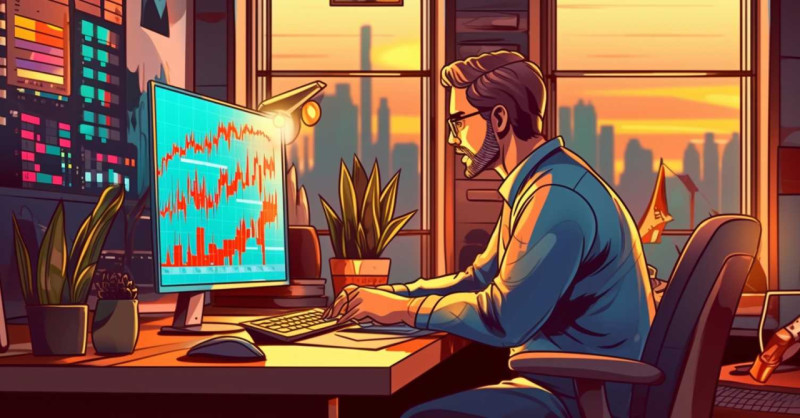
Storage (HDD vs. SSD)
The digital age has brought forth a significant shift in how we store and access data, and in the sphere of trading, the evolution of storage devices plays an even more crucial role. When contemplating storage options, traders are often met with two primary choices: the traditional Hard Disk Drive (HDD) and the more modern Solid State Drive (SSD). Both have their merits, but there's a distinct advantage that SSDs bring to the trading table.
The need for speed is paramount in trading. When executing trades, analyzing vast datasets, or loading multiple applications, the speed at which data is accessed can be the difference between seizing an opportunity or missing it entirely. This is where SSDs truly shine. Unlike HDDs, which rely on spinning disks to read or write data, SSDs use flash memory. This absence of moving parts not only leads to faster data access but also ensures a lower risk of mechanical failures. Simply put, SSDs can read and write data at a speed that HDDs can't match, translating to faster boot times, quicker application launches, and overall smoother system performance.
Reliability is another cornerstone of trading. Downtimes, data losses, or system failures can be catastrophic. SSDs, with their lack of moving components, are inherently more durable and less prone to physical damage compared to HDDs. This robust nature ensures a longer lifespan and decreased likelihood of unexpected data loss.
Now, while HDDs might offer more storage space for a lower price, the adage "you get what you pay for" rings true in this context. For traders, the speed and reliability benefits of SSDs overwhelmingly justify their higher price tag. The instantaneous data access and dependable nature of SSDs make them the preferred choice for trading, ensuring that the technical aspects of a trader's operation are as swift and reliable as their decision-making skills.
In summary, while both HDDs and SSDs have their place in the world of computers, when it comes to trading, the choice leans heavily in favor of SSDs. Embracing this modern storage solution is akin to embracing a more efficient, reliable, and agile trading experience.
Graphics Card (GPU)
In the vast landscape of trading components, the Graphics Processing Unit (GPU), or more commonly known as the graphics card, occupies a unique position. While traditionally associated with gaming or graphics-intensive tasks, its importance in a trader's setup, especially for those employing multiple monitors, is profound.
The modern trader's desk, dotted with multiple screens showcasing charts, news feeds, and trading platforms, is a testament to the need for simultaneous access to varied information. Each of these screens requires a distinct output, and managing these outputs smoothly is the domain of the GPU. A potent graphics card ensures that each monitor displays crisp, lag-free visuals, allowing traders to interpret data without strain or disruption.
Moreover, with the rise of high-definition and 4K monitors, the demand on graphics cards has surged. A robust GPU ensures that even at these high resolutions, the display remains seamless, enhancing the clarity and precision of data interpretation.
For traders, while the need for a top-tier gaming GPU might be overkill, investing in a mid-range dedicated graphics card is a wise choice. Integrated graphics, which come built into many CPUs, may suffice for basic tasks, but they often falter under the strain of multiple high-resolution displays. Brands like NVIDIA and AMD offer a range of GPUs that cater to different needs. For a trading setup, consider GPUs that support multi-display outputs and have a good amount of dedicated video memory (VRAM), preferably 4GB or more.
In addition, while evaluating options, it's beneficial to check the number and types of ports the GPU offers, ensuring compatibility with the monitor connections, be it HDMI, DisplayPort, or others.
In conclusion, the graphics card, often overshadowed by components like the CPU in trading discussions, holds its own in ensuring a seamless, efficient trading environment. Especially for those traders who rely on multi-monitor setups, the GPU stands as a pillar of clarity, precision, and smooth visual performance. Investing in a reliable graphics card is, in essence, investing in a clearer, more comprehensive view of the market's ebb and flow.

Connectivity
In the interconnected world of trading, where real-time data is king, the importance of robust connectivity cannot be overstressed. A trader's decisions, no matter how astute, are only as effective as the speed and stability with which they can be executed.
Every trader knows the anxiety of waiting for a trade to go through, the uncertainty amplified when the internet connection is unstable. Even a few seconds of delay can lead to substantial financial implications, especially in high-frequency trading where milliseconds matter. Moreover, real-time news feeds, live charts, and other essential trading tools are all dependent on a steady internet flow. Interruptions or lags in these can distort a trader's view of the market, potentially leading to misguided decisions.
While Wi-Fi has made significant strides in speed and reliability, when it comes to trading, Ethernet still holds the upper hand. Here's why:
Stability: Ethernet connections, being hardwired, inherently face fewer disturbances compared to Wi-Fi, which can be affected by various factors like physical obstructions, interference from other devices, and even atmospheric conditions.
Consistent Speeds: While Wi-Fi speeds can fluctuate based on the aforementioned factors, Ethernet provides a consistent bandwidth, ensuring that data transfer rates remain stable throughout.
Lower Latency: For traders, every millisecond counts. Ethernet connections typically offer lower latency compared to Wi-Fi. This means faster data transfers, quicker trade executions, and minimal delays in accessing real-time data.
Security: A wired connection is generally more secure than a wireless one. While this might not directly impact trading speeds, it does add an extra layer of protection against potential cyber threats, ensuring the safety of one's trading activities and data.
In essence, while Wi-Fi might offer the allure of convenience, for activities as critical as trading, the stability, speed, and security offered by Ethernet make it the preferred choice. A trader's success is built on a foundation of accurate, timely information and swift execution. Ensuring optimal connectivity is not just a technical requirement; it's a strategic advantage in the fast-paced world of trading.
Multiple Monitors
In the bustling hubbub of trading floors and home trading setups alike, a prevalent sight is a maze of screens, each flickering with charts, news, and data. This is no aesthetic choice; multiple monitors have become an indispensable tool for traders aiming to stay atop the ever-shifting sands of financial markets.
Advantage of Multiple Screens for Tracking Different Indices
The financial world is vast, with numerous indices, commodities, stocks, and currencies all moving concurrently. Each of these can influence the other, and for traders, having an eagle-eye view becomes imperative. Multiple monitors cater to this need by providing the real estate to display different information side by side.
For instance, while one screen can be dedicated to tracking the movement of a particular stock, another could be monitoring global news, which might influence stock prices. Yet another could have analytical tools running, offering insights based on historical data. This compartmentalization ensures that traders don’t have to toggle between tabs or windows, reducing the risk of missing out on crucial information and aiding in faster decision-making.
Recommendations on Number and Type
Number of Monitors: For most traders, a dual-monitor setup can significantly enhance productivity. However, for those deeply entrenched in day trading or forex markets where multiple parameters need constant monitoring, setups with three to six monitors aren't uncommon. The key is to strike a balance; while more screens provide more information, they should not become overwhelming or cluttered.
Type of Monitor: When choosing monitors for trading:
- Resolution: Opt for at least a Full HD (1920x1080) resolution to ensure clarity. Those with a higher budget can consider 4K monitors, which offer even more screen space and sharper visuals.
- Size: A size range of 24 to 27 inches is most common for trading setups. It offers ample screen space without being overly cumbersome.
- Refresh Rate: A 60Hz refresh rate is generally sufficient for trading. High refresh rates, often associated with gaming monitors, aren't a necessity for trading tasks.
- Connectivity: Ensure the monitor has compatible ports for your computer and graphics card, such as HDMI, DisplayPort, or DVI.
- Adjustability: Monitors with adjustable stands (tilt, swivel, height adjustment) can be positioned for optimal ergonomics, reducing strain during long trading sessions.
In conclusion, the advent of multiple monitors in trading setups isn't just a trend but a testament to their utility. They offer traders the expanse to view, analyze, and act upon diverse information sources simultaneously. As the world of trading continues to evolve, being equipped with the right tools, like a multi-monitor setup, can be the edge that differentiates a successful trader from the rest.

Pre-built vs. Custom-built Best Computer for Trading
The decision to choose between a pre-built or a custom-built trading computer can be likened to choosing between buying a ready-made suit or getting one tailored. Both have their merits and downsides. In the world of trading, where the stakes are high, making an informed decision on this front becomes even more crucial.
Pre-built Trading Computers
Advantages:
- Convenience: For those not well-versed in computer hardware, pre-built systems offer a hassle-free route. Everything comes set up, with compatible components and pre-installed software.
- Warranty: Most pre-built systems come with a comprehensive warranty for the entire unit, ensuring peace of mind in case of hardware issues.
- Customer Support: Established brands often offer robust customer support, aiding users in troubleshooting or potential upgrades.
Disadvantages:
- Cost: Pre-built computers often carry a premium over the sum of their parts due to assembly, branding, and the convenience factor.
- Generic Builds: Such systems might not always cater to specific trading needs and may have components that are either overpowered or lacking.
- Bloatware: Some manufacturers preload software that may not be necessary, taking up storage and sometimes affecting performance.
Custom-built Trading Computers
Advantages:
- Personalization: A custom-built system allows for a tailor-made configuration, ensuring every component aligns with the trader's specific needs.
- Cost-Efficient: By selecting individual components, traders can often get a better performance-to-cost ratio.
- Upgradability: Custom setups are generally easier to upgrade, as the user knows the system intricacies and can swap out parts as needed.
Disadvantages:
- Complexity: Building a computer requires research and some technical know-how. It can be daunting for those unfamiliar with computer hardware.
- Warranty Variances: While individual parts come with warranties, managing multiple warranties for different components can be cumbersome.
- Potential for Errors: Incorrect assembly or part incompatibility can lead to performance issues or hardware failures.
What to Consider When Choosing Between the Two:
- Technical Know-how: If you're comfortable with computer components and the idea of assembling them, a custom-built might be the way to go. If not, a pre-built offers simplicity.
- Budget: Custom-built systems often provide better value for money, but pre-built systems offer the convenience of a one-time purchase without the assembly hassle.
- Specific Needs: Determine your exact requirements. If standard pre-built systems meet these, they might be a good choice. But if you have specialized needs, a custom-built system will offer more flexibility.
- Support and Warranty: If the idea of a single warranty and dedicated customer support appeals to you, pre-built computers have an edge.
In essence, the choice between pre-built and custom-built trading computers boils down to individual preferences, technical comfort levels, and trading needs. Both options have their merits; the key is to align the choice with one's unique requirements and circumstances.
Top 5 Pre-built Best Computers for Trading in 2023
Navigating the sea of computer options can be daunting. For traders, the stakes are even higher, given the need for reliability, speed, and multitasking capabilities. Based on the latest trends and reviews, here are the top 5 pre-built computers for trading in 2023:
1. Dell XPS 8930 Desktop
- Key Specifications: 9th Gen Intel Core i7, 16GB RAM, 512GB SSD + 2TB HDD, NVIDIA GeForce GTX 1660.
- Features: Compact design, expandable storage, VR-ready.
- Price Range: $1,100 - $1,300
- Where to Buy: Dell's official website, major electronics retailers, and e-commerce platforms.
2. HP Envy TE01-1020
- Key Specifications: 10th Gen Intel Core i7, 16GB RAM, 1TB SSD, Integrated Intel UHD Graphics 630.
- Features: Aesthetically pleasing design, built-in Wi-Fi 6, tool-less access for upgrades.
- Price Range: $900 - $1,100
- Where to Buy: HP's official website, leading electronic stores, and online marketplaces.
3. Lenovo ThinkCentre M920 Tower
- Key Specifications: 9th Gen Intel Core i7, 32GB RAM, 1TB SSD + 2TB HDD, NVIDIA GeForce GT 730.
- Features: Robust security features, energy efficient, easy expandability.
- Price Range: $1,200 - $1,400
- Where to Buy: Lenovo's official website, major electronics outlets, and online retailers.
4. Acer Aspire TC-895-UA92
- Key Specifications: 10th Gen Intel Core i5, 12GB RAM, 512GB SSD, Intel UHD Graphics 630.
- Features: Compact size, multiple USB 3.2 ports, built-in Wi-Fi 6.
- Price Range: $600 - $800
- Where to Buy: Acer's official site, electronic shops, and major e-commerce platforms.
5. Apple iMac (27-inch, 2022)
- Key Specifications: 10-core Apple M1 chip, 16GB RAM, 512GB SSD, Apple GPU 16-core.
- Features: Retina 5K display, True Tone technology, excellent built-in speakers.
- Price Range: $1,800 - $2,200
- Where to Buy: Apple's official website, Apple stores, and authorized resellers.
For those serious about trading, investing in a reliable computer is paramount. While this list serves as a starting point, always ensure to check the latest reviews, specifications, and prices before making a purchase. It's also worthwhile to consider future upgrade needs, ensuring that the chosen system remains a robust trading companion for years to come.
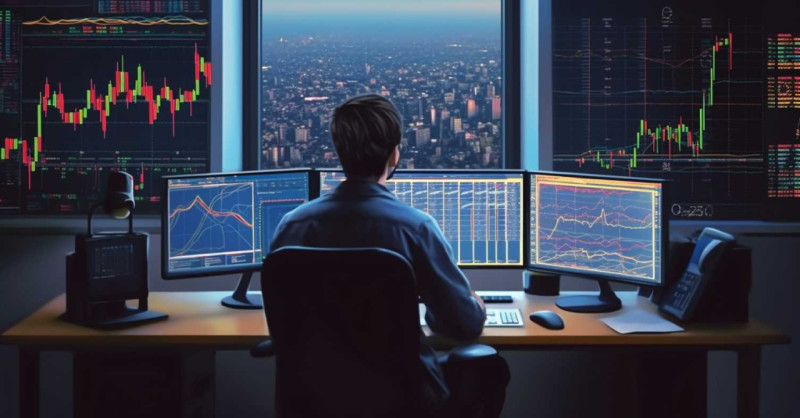
Considerations when Building a Custom Best Computer for Trading
Embarking on the journey to build a custom trading computer is exciting. It provides an opportunity to tailor every component to your specific trading needs. However, the process is also fraught with choices and potential pitfalls. Here's what to consider to ensure your custom-built machine delivers optimal performance without unnecessary expenses:
Choosing the Right Components Based on Need
Processor (CPU): For trading, a fast multi-core processor is crucial. This ensures quick data processing, especially when running multiple applications. While top-tier processors might seem tempting, for most traders, a mid-to-high range CPU should suffice.
Memory (RAM): Trading platforms, especially when multiple are open concurrently, can be memory-intensive. Aim for at least 16GB RAM, but if budget allows, 32GB offers a comfortable buffer.
Storage: SSDs are the gold standard, offering speed and reliability. Consider a primary SSD for your operating system and trading platforms, and a secondary, larger HDD or SSD for data storage.
Graphics Card (GPU): Multiple monitor setups are common in trading, requiring a robust GPU. While high-end gaming GPUs might be overkill, ensure the GPU can comfortably support the number and resolution of monitors you plan to use.
Connectivity: A motherboard with built-in Ethernet and multiple USB ports is essential. Additionally, consider other connectivity options like HDMI, DisplayPort, or DVI for multiple monitor setups.
Cost-Effectiveness vs. Performance
Balanced Spending: It's easy to overspend on top-tier components, but for trading, the law of diminishing returns often applies. Once a certain performance level is reached, additional spending might not yield significant improvements.
Future-Proofing: Invest in components that have a longer shelf-life in terms of performance. This might mean spending slightly more now to avoid frequent upgrades in the near future.
Bundled Deals: Often, retailers offer bundled deals on components (e.g., motherboard and CPU). Look out for these to save some money.
Potential Pitfalls and Common Mistakes
Incompatible Components: Always check the compatibility of components. For instance, ensure the CPU socket matches the motherboard and the RAM is compatible in terms of speed and type.
Overlooking the Power Supply (PSU): Ensure the PSU can handle the total wattage of your components with some room to spare. Also, opt for a reputable brand to avoid power inconsistencies.
Skimping on Cooling: Trading might not heat up your PC like gaming does, but a well-cooled system ensures longevity and performance. Consider a quality air or liquid cooling solution.
Forgetting Software Costs: Remember, the operating system and certain trading software might come at additional costs. Factor these into your budget.
Neglecting Ergonomics: While focusing on internal components, don't forget the peripherals. A comfortable chair, a quality keyboard and mouse, and well-placed monitors can make trading sessions much more pleasant.
Building a custom trading computer can be a rewarding experience, both in terms of the building process and the performance gains. By carefully choosing components based on actual needs, balancing cost and performance, and avoiding common pitfalls, you can create a powerful trading machine that serves you well in the dynamic world of finance.
Additional Features to Consider
Beyond the core components of a trading computer, several additional features can play pivotal roles in enhancing the system's reliability and longevity. In the demanding environment of trading, where every second counts and downtime can be costly, these additional features can make a substantial difference. Let's delve into a few of them:
Uninterruptible Power Supply (UPS)
Trading requires constant connection and real-time data. An unexpected power outage can not only disrupt trades but can also harm your computer hardware.
Instant Power: A UPS provides instantaneous power during outages, ensuring your trading activities remain uninterrupted.
Protection from Surges: UPS units often come with built-in surge protectors, shielding your system from potential electrical damage.
Safe Shutdown: A UPS provides a critical window to save your work and shut down your computer gracefully, preventing data loss or corruption.
Selection Tip: When choosing a UPS, consider the power requirement of your computer and the desired backup time. This will help determine the capacity you need.
Cooling Systems
While trading isn't as demanding on a computer as gaming or graphic design might be, maintaining optimal temperatures is crucial for the longevity and consistent performance of your machine.
Air Cooling: Comprises of fans and heat sinks. They're typically more affordable and easier to install. Regularly cleaning the fans and ensuring unobstructed airflow is essential.
Liquid Cooling: Uses liquid coolant to absorb heat and dissipate it through radiators. While generally more efficient and quieter than air cooling, it's also more expensive and can be complex to install.
Room Ventilation: Beyond internal cooling, ensure your computer's location has adequate ventilation. Overheating can reduce component lifespan and degrade performance.
Reliable Backup Systems
In the world of trading, data is gold. From trade histories to strategy formulations, ensuring this data is safe is paramount.
External Hard Drives: A simple and effective solution. Regularly backup crucial data to an external drive. It's recommended to store this drive in a different location to guard against physical dangers like fires or floods.
Cloud Backup: Services like Dropbox, Google Drive, or specialized backup services automatically sync your data to the cloud. They offer accessibility from anywhere and protection against local data threats.
RAID Systems: Some traders set up Redundant Array of Independent Disks (RAID) systems. They use multiple hard drives to provide data redundancy, ensuring data isn't lost if one drive fails.
Regular Backup Schedule: Whichever backup method you choose, consistency is key. Set a regular backup schedule, be it daily, weekly, or monthly, based on the volume and importance of your data.
Incorporating these additional features might seem like supplementary steps, but they're critical in crafting a reliable, durable trading setup. They offer peace of mind, ensuring you can focus on trading without worrying about hardware failures, data losses, or unexpected disruptions.
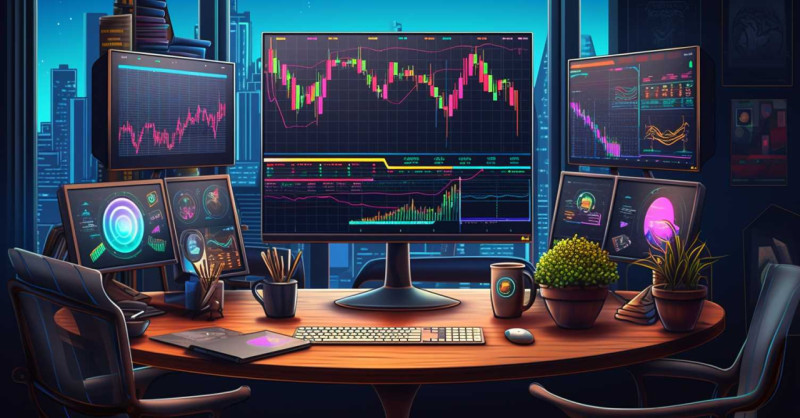
Best Computer for Trading: Software Considerations
Just as the physical aspects of your trading computer are pivotal, the software ecosystem you immerse it in is equally critical. From ensuring seamless trades to accessing real-time market data, the right software can be the difference between profit and loss. Let's look into the nuances of trading software considerations:
Importance of Having Up-to-Date and Compatible Trading Software
Real-Time Data Access: The markets don't sleep, and outdated software can hinder access to real-time data. Regular software updates ensure you're not trading based on lagging indicators.
Security: Financial markets are often targeted by cyber threats. Running outdated software can expose you to vulnerabilities, jeopardizing your funds and personal information.
Enhanced Features: Trading software developers constantly work to improve user experience, offering new tools, better user interfaces, and improved functionality with each update.
Compatibility: Ensuring that your software is compatible with your system's specifications is crucial. Incompatibility can lead to crashes, slow performance, and errors.
A Brief List of Top Trading Platforms and Their System Requirements
MetaTrader 4 (MT4)
- Platform Overview: One of the most popular forex trading platforms, MT4 offers automated trading through its proprietary scripting language.
- System Requirements: Windows 7 or higher, 1 GHz processor, 512 MB RAM, and screen resolution of 1024x768.
Thinkorswim by TD Ameritrade
- Platform Overview: Suited for advanced traders, it offers robust charting tools, simulations, and futures and forex trading.
- System Requirements: Windows 7 or higher/Mac OS X 10.7 or later, 3 GHz processor, 8 GB RAM, and a 512 MB video card.
NinjaTrader
- Platform Overview: Known for its advanced analysis capabilities, NinjaTrader also offers automated trading features.
- System Requirements: Windows 8 or newer, 1 GHz processor, 2 GB RAM, and DirectX 10 compatible graphics.
Interactive Brokers' Trader Workstation (TWS)
- Platform Overview: TWS is designed for active and professional traders and offers tools like SpreadTrader.
- System Requirements: Windows 7 or higher/Mac OS X 10.11 or later, 2 GHz or faster processor, 4 GB RAM, and screen resolution of 1280x1024.
eSignal
- System Requirements: Windows 7 or newer, 1.8 GHz or faster processor, 4 GB RAM, and 500 MB free hard disk space.
Before committing to any trading platform, always cross-check its system requirements against your computer's specifications. Additionally, consider the platform's fees, available instruments, and features to ensure it aligns with your trading style and goals. Regularly updating your software and ensuring compatibility with your hardware will provide a seamless trading experience.
Maintenance Tips to Ensure Optimal Performance
Every trader understands that time is of the essence. In the world of split-second decisions, maintaining optimal computer performance is crucial. Much like how a professional athlete ensures their gear is in top condition, traders should periodically maintain their systems. Here's a guide on keeping your trading computer performing at its peak:
Regular System Check-Ups
Disk Cleanups: Over time, computers accumulate unnecessary files. Using built-in tools like "Disk Cleanup" on Windows or third-party applications can help you identify and remove these files, freeing up storage and improving system performance.
Defragmentation: For those using HDDs, defragmenting the disk can help reorganize data, making it more accessible and speeding up the system. However, this isn't necessary for SSDs.
Health Monitoring: Use software tools to monitor the health and temperature of components like the CPU, GPU, and hard drives. Overheating or failing components can be early indicators of potential problems.
Importance of Software Updates
Operating System Updates: Ensure your OS is regularly updated. These updates often come with security patches, bug fixes, and performance enhancements.
Trading Software Updates: As discussed earlier, keeping your trading software updated ensures access to the latest features, improved security, and better overall performance.
Driver Updates: Hardware drivers act as intermediaries between your system's hardware and software. Regularly updating them ensures compatibility, reduces the chance of crashes, and often improves performance.
Cleaning and Upkeep to Extend Lifespan
Physical Cleaning: Dust accumulation can clog vents and fans, leading to overheating. Periodically turn off and unplug your system and use compressed air to gently clean out dust from the vents, fans, and other components. If you're comfortable, opening the computer case can allow for a more thorough cleaning.
Monitor Maintenance: Clean your monitors with a soft microfiber cloth and a solution suitable for screen cleaning. This ensures clarity and reduces eye strain.
Keyboard and Mouse Cleaning: These peripherals often harbor more germs than one might expect. Regularly wipe them down with appropriate cleaning solutions.
Environment: Ensure your computer is positioned in a well-ventilated area, away from direct sunlight or heat sources. This aids in temperature regulation. Also, try to maintain a clean, dust-free environment to reduce the frequency of internal cleanings.
Cable Management: Organize cables using clips, ties, or sleeves. This not only creates a cleaner workspace but also reduces the risk of accidents or unplugging crucial components accidentally.
Maintenance is an ongoing commitment. But with regular attention and care, traders can ensure their computers remain efficient, reliable, and ready to handle the demanding world of trading. These practices can significantly extend the lifespan of your machine, making it a worthy investment of your time.
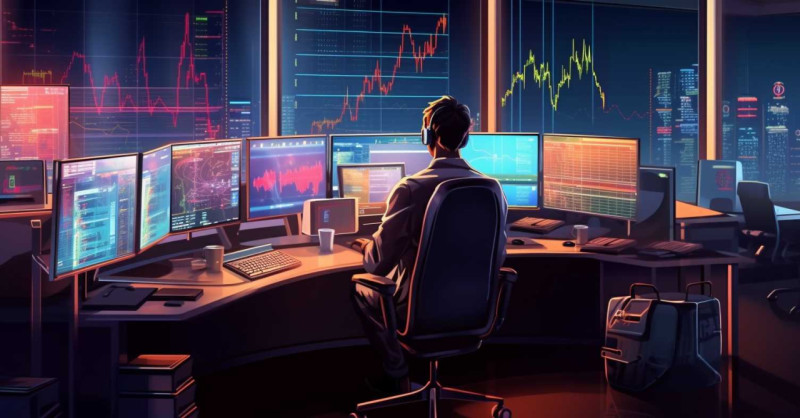
Conclusion
In the intricate landscape of trading, the right tools can make all the difference. We've journeyed through the essential hardware components, software considerations, and the importance of maintenance. Each facet of this discussion reinforces a singular idea: the value of having the best possible computer system for your trading endeavors.
Choosing the best computer isn't merely about having a machine to execute trades. It's about reliability, speed, and ensuring that no technological hiccup stands between you and the ever-fluctuating markets. It's about being empowered to multitask efficiently, have real-time data at your fingertips, and to operate without unnecessary hindrance.
But beyond the technical, there's an inherent psychological benefit. Knowing you have a top-tier system allows for peace of mind. It's one less variable to worry about in the already complex world of trading.
So, as you venture into or continue your journey in the trading world, remember that investing in quality hardware and software isn't just about spending money; it's about investing in your success. The dividends that this investment can yield—in terms of both profits and peace of mind—are invaluable.
Embrace excellence. Elevate your trading experience. Investing in quality today can be the bedrock of your trading success tomorrow. Don't compromise; the stakes are too high. Ensure your tech matches the caliber of your ambitions. Happy trading!













